Operational Project Management: Case Studies, Analysis, and Solutions
VerifiedAdded on 2023/01/05
|19
|3696
|87
Project
AI Summary
This project management assignment analyzes several operational challenges faced by different businesses. The assignment begins with an analysis of coffee procurement strategies for Harvey Talbot, comparing the Economic Order Quantity (EOQ) method with bulk purchasing, and evaluating the merits and demerits of different approaches. It then examines the operational processes and staffing needs of a new Juice Masters outlet. The assignment also addresses staff planning for a Turista call center, including cost analysis of different staffing models and the implementation of a web-based call handling system. Furthermore, it assesses the production capacity and profitability of Sycamore Security Systems, identifying bottlenecks and suggesting improvements. Finally, the assignment investigates baggage handling problems at Snowham Airport, including cost analysis and business value assessment of proposed solutions, as well as the acquisition of a new fire engine. The assignment provides detailed calculations, comparisons, and recommendations for each case study, offering valuable insights into operational efficiency and cost management.
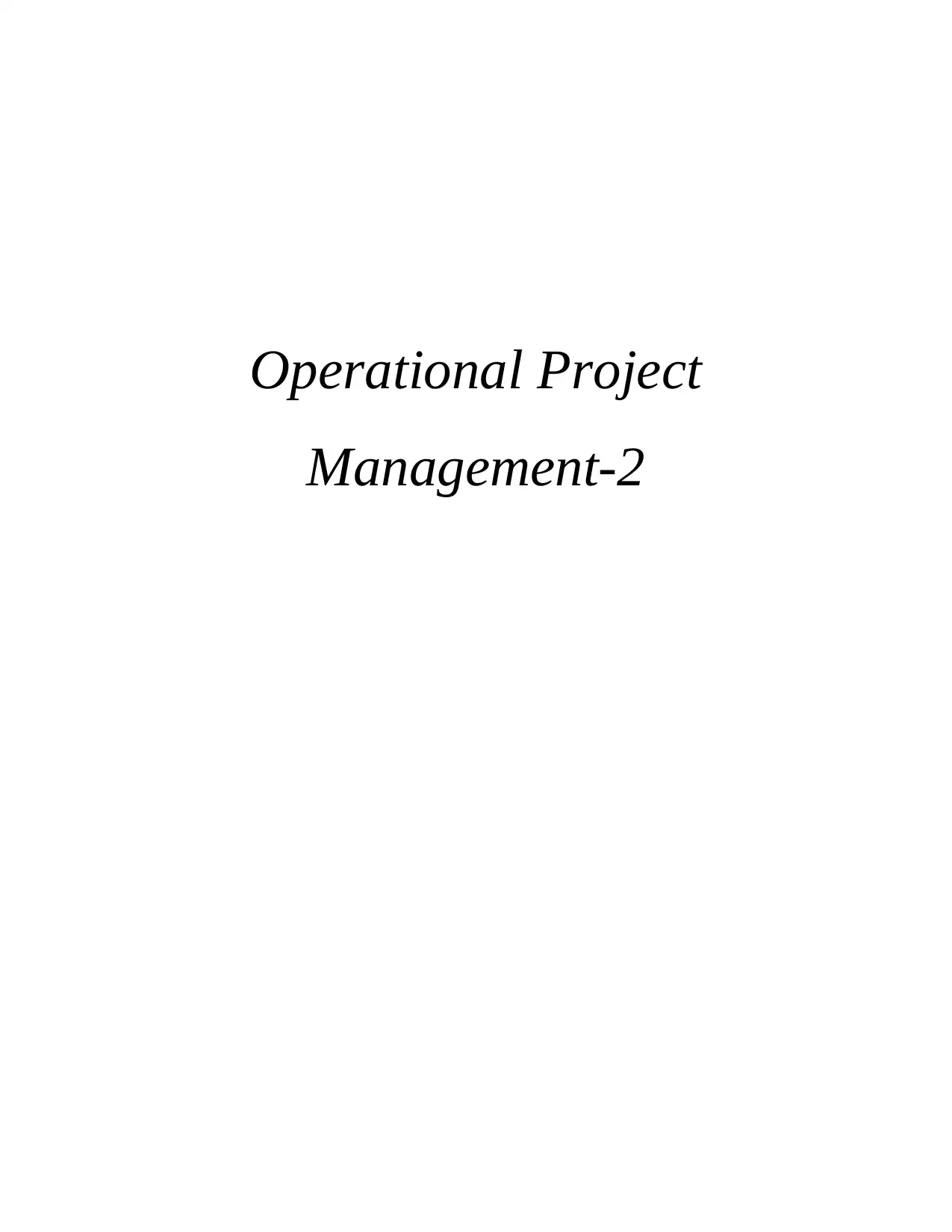
Operational Project
Management-2
Management-2
Paraphrase This Document
Need a fresh take? Get an instant paraphrase of this document with our AI Paraphraser
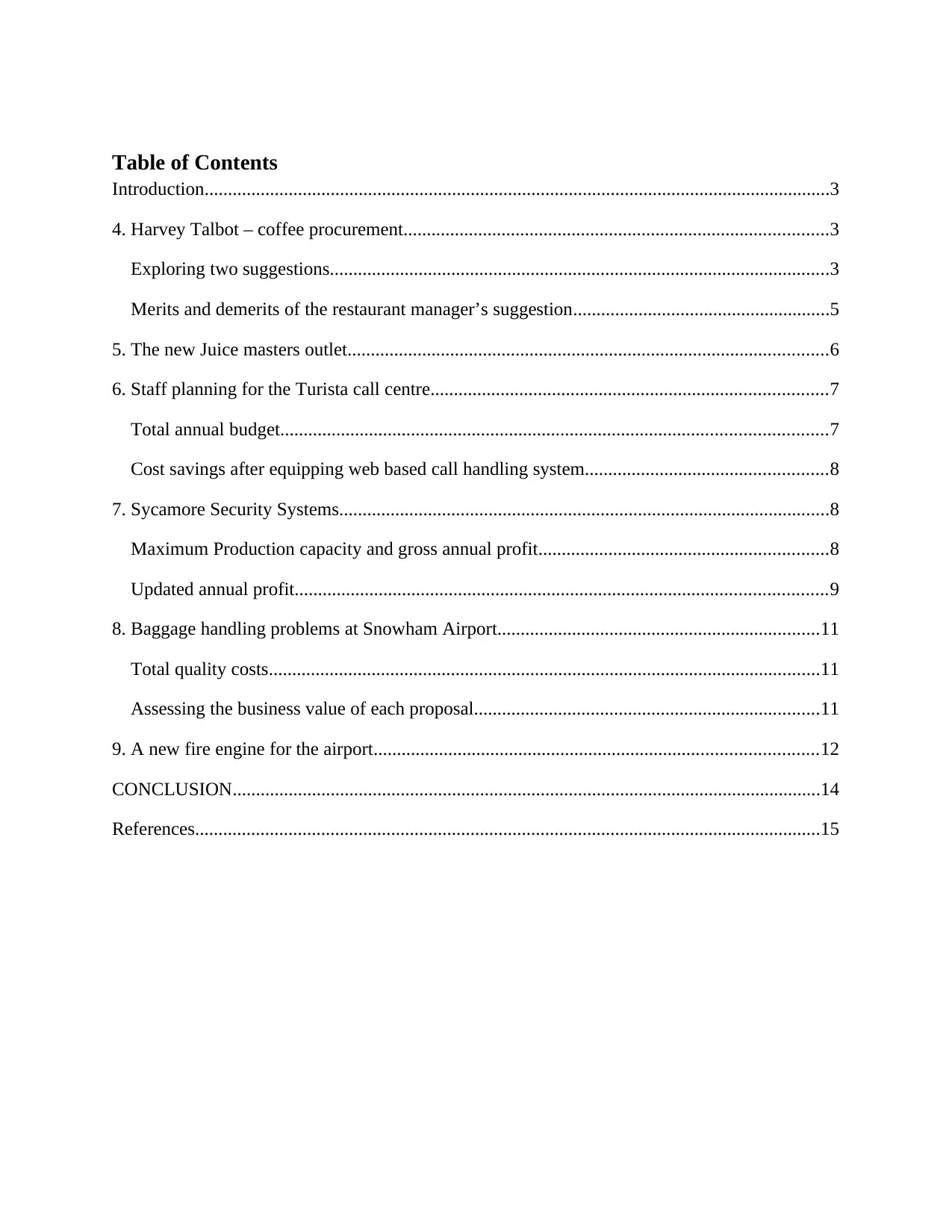
Table of Contents
Introduction......................................................................................................................................3
4. Harvey Talbot – coffee procurement...........................................................................................3
Exploring two suggestions...........................................................................................................3
Merits and demerits of the restaurant manager’s suggestion.......................................................5
5. The new Juice masters outlet.......................................................................................................6
6. Staff planning for the Turista call centre.....................................................................................7
Total annual budget.....................................................................................................................7
Cost savings after equipping web based call handling system....................................................8
7. Sycamore Security Systems.........................................................................................................8
Maximum Production capacity and gross annual profit..............................................................8
Updated annual profit..................................................................................................................9
8. Baggage handling problems at Snowham Airport.....................................................................11
Total quality costs......................................................................................................................11
Assessing the business value of each proposal..........................................................................11
9. A new fire engine for the airport...............................................................................................12
CONCLUSION..............................................................................................................................14
References......................................................................................................................................15
Introduction......................................................................................................................................3
4. Harvey Talbot – coffee procurement...........................................................................................3
Exploring two suggestions...........................................................................................................3
Merits and demerits of the restaurant manager’s suggestion.......................................................5
5. The new Juice masters outlet.......................................................................................................6
6. Staff planning for the Turista call centre.....................................................................................7
Total annual budget.....................................................................................................................7
Cost savings after equipping web based call handling system....................................................8
7. Sycamore Security Systems.........................................................................................................8
Maximum Production capacity and gross annual profit..............................................................8
Updated annual profit..................................................................................................................9
8. Baggage handling problems at Snowham Airport.....................................................................11
Total quality costs......................................................................................................................11
Assessing the business value of each proposal..........................................................................11
9. A new fire engine for the airport...............................................................................................12
CONCLUSION..............................................................................................................................14
References......................................................................................................................................15
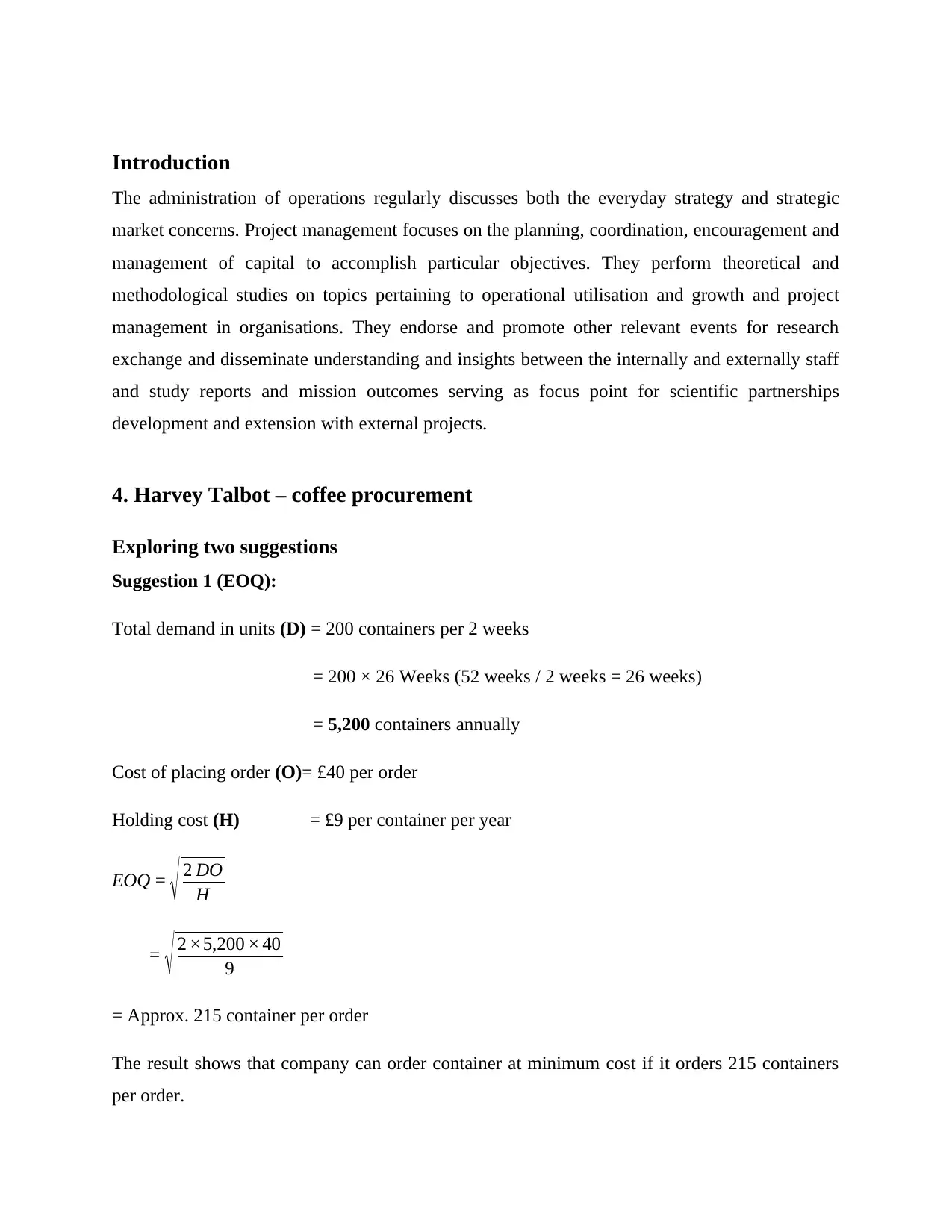
Introduction
The administration of operations regularly discusses both the everyday strategy and strategic
market concerns. Project management focuses on the planning, coordination, encouragement and
management of capital to accomplish particular objectives. They perform theoretical and
methodological studies on topics pertaining to operational utilisation and growth and project
management in organisations. They endorse and promote other relevant events for research
exchange and disseminate understanding and insights between the internally and externally staff
and study reports and mission outcomes serving as focus point for scientific partnerships
development and extension with external projects.
4. Harvey Talbot – coffee procurement
Exploring two suggestions
Suggestion 1 (EOQ):
Total demand in units (D) = 200 containers per 2 weeks
= 200 × 26 Weeks (52 weeks / 2 weeks = 26 weeks)
= 5,200 containers annually
Cost of placing order (O)= £40 per order
Holding cost (H) = £9 per container per year
EOQ = √ 2 DO
H
= √ 2 ×5,200 × 40
9
= Approx. 215 container per order
The result shows that company can order container at minimum cost if it orders 215 containers
per order.
The administration of operations regularly discusses both the everyday strategy and strategic
market concerns. Project management focuses on the planning, coordination, encouragement and
management of capital to accomplish particular objectives. They perform theoretical and
methodological studies on topics pertaining to operational utilisation and growth and project
management in organisations. They endorse and promote other relevant events for research
exchange and disseminate understanding and insights between the internally and externally staff
and study reports and mission outcomes serving as focus point for scientific partnerships
development and extension with external projects.
4. Harvey Talbot – coffee procurement
Exploring two suggestions
Suggestion 1 (EOQ):
Total demand in units (D) = 200 containers per 2 weeks
= 200 × 26 Weeks (52 weeks / 2 weeks = 26 weeks)
= 5,200 containers annually
Cost of placing order (O)= £40 per order
Holding cost (H) = £9 per container per year
EOQ = √ 2 DO
H
= √ 2 ×5,200 × 40
9
= Approx. 215 container per order
The result shows that company can order container at minimum cost if it orders 215 containers
per order.
⊘ This is a preview!⊘
Do you want full access?
Subscribe today to unlock all pages.

Trusted by 1+ million students worldwide
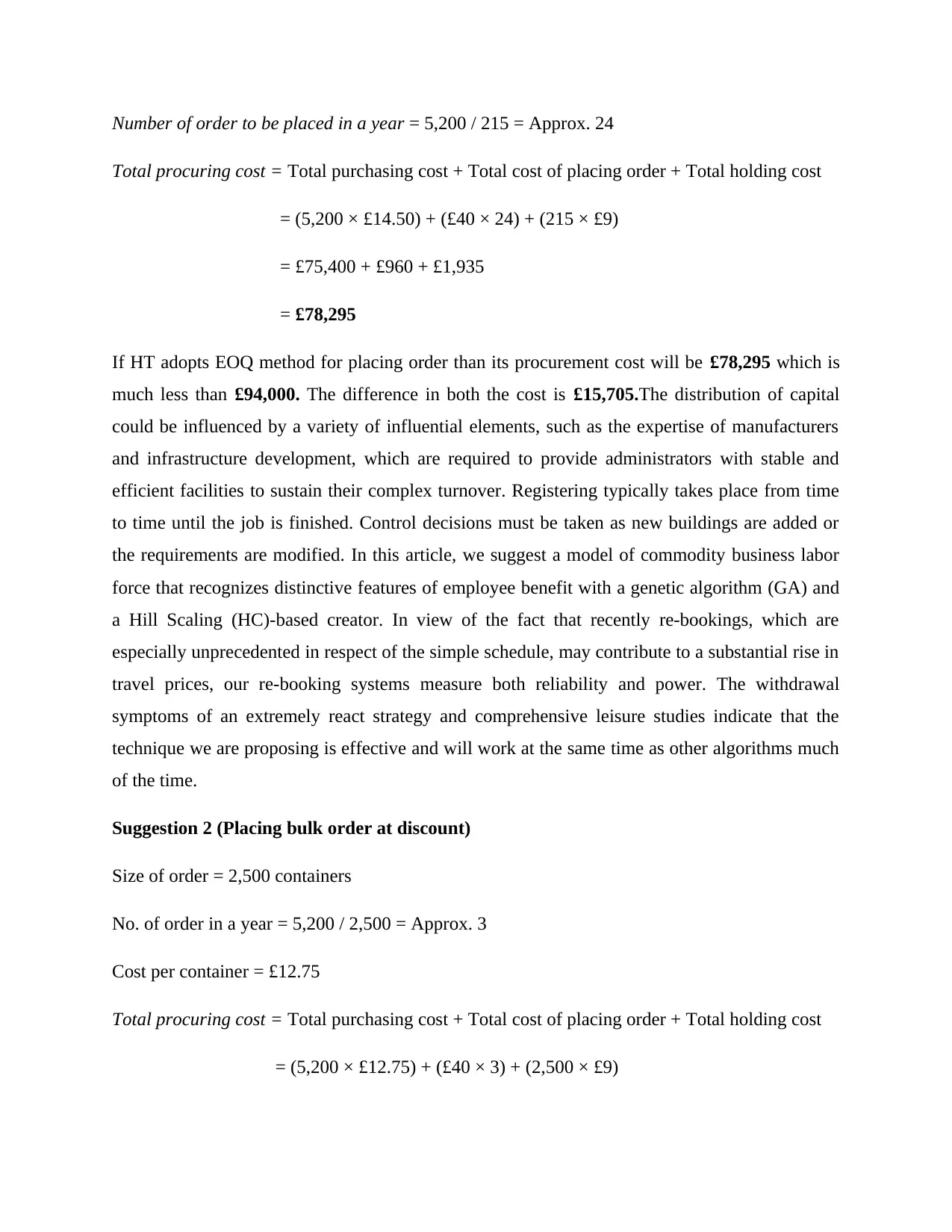
Number of order to be placed in a year = 5,200 / 215 = Approx. 24
Total procuring cost = Total purchasing cost + Total cost of placing order + Total holding cost
= (5,200 × £14.50) + (£40 × 24) + (215 × £9)
= £75,400 + £960 + £1,935
= £78,295
If HT adopts EOQ method for placing order than its procurement cost will be £78,295 which is
much less than £94,000. The difference in both the cost is £15,705.The distribution of capital
could be influenced by a variety of influential elements, such as the expertise of manufacturers
and infrastructure development, which are required to provide administrators with stable and
efficient facilities to sustain their complex turnover. Registering typically takes place from time
to time until the job is finished. Control decisions must be taken as new buildings are added or
the requirements are modified. In this article, we suggest a model of commodity business labor
force that recognizes distinctive features of employee benefit with a genetic algorithm (GA) and
a Hill Scaling (HC)-based creator. In view of the fact that recently re-bookings, which are
especially unprecedented in respect of the simple schedule, may contribute to a substantial rise in
travel prices, our re-booking systems measure both reliability and power. The withdrawal
symptoms of an extremely react strategy and comprehensive leisure studies indicate that the
technique we are proposing is effective and will work at the same time as other algorithms much
of the time.
Suggestion 2 (Placing bulk order at discount)
Size of order = 2,500 containers
No. of order in a year = 5,200 / 2,500 = Approx. 3
Cost per container = £12.75
Total procuring cost = Total purchasing cost + Total cost of placing order + Total holding cost
= (5,200 × £12.75) + (£40 × 3) + (2,500 × £9)
Total procuring cost = Total purchasing cost + Total cost of placing order + Total holding cost
= (5,200 × £14.50) + (£40 × 24) + (215 × £9)
= £75,400 + £960 + £1,935
= £78,295
If HT adopts EOQ method for placing order than its procurement cost will be £78,295 which is
much less than £94,000. The difference in both the cost is £15,705.The distribution of capital
could be influenced by a variety of influential elements, such as the expertise of manufacturers
and infrastructure development, which are required to provide administrators with stable and
efficient facilities to sustain their complex turnover. Registering typically takes place from time
to time until the job is finished. Control decisions must be taken as new buildings are added or
the requirements are modified. In this article, we suggest a model of commodity business labor
force that recognizes distinctive features of employee benefit with a genetic algorithm (GA) and
a Hill Scaling (HC)-based creator. In view of the fact that recently re-bookings, which are
especially unprecedented in respect of the simple schedule, may contribute to a substantial rise in
travel prices, our re-booking systems measure both reliability and power. The withdrawal
symptoms of an extremely react strategy and comprehensive leisure studies indicate that the
technique we are proposing is effective and will work at the same time as other algorithms much
of the time.
Suggestion 2 (Placing bulk order at discount)
Size of order = 2,500 containers
No. of order in a year = 5,200 / 2,500 = Approx. 3
Cost per container = £12.75
Total procuring cost = Total purchasing cost + Total cost of placing order + Total holding cost
= (5,200 × £12.75) + (£40 × 3) + (2,500 × £9)
Paraphrase This Document
Need a fresh take? Get an instant paraphrase of this document with our AI Paraphraser
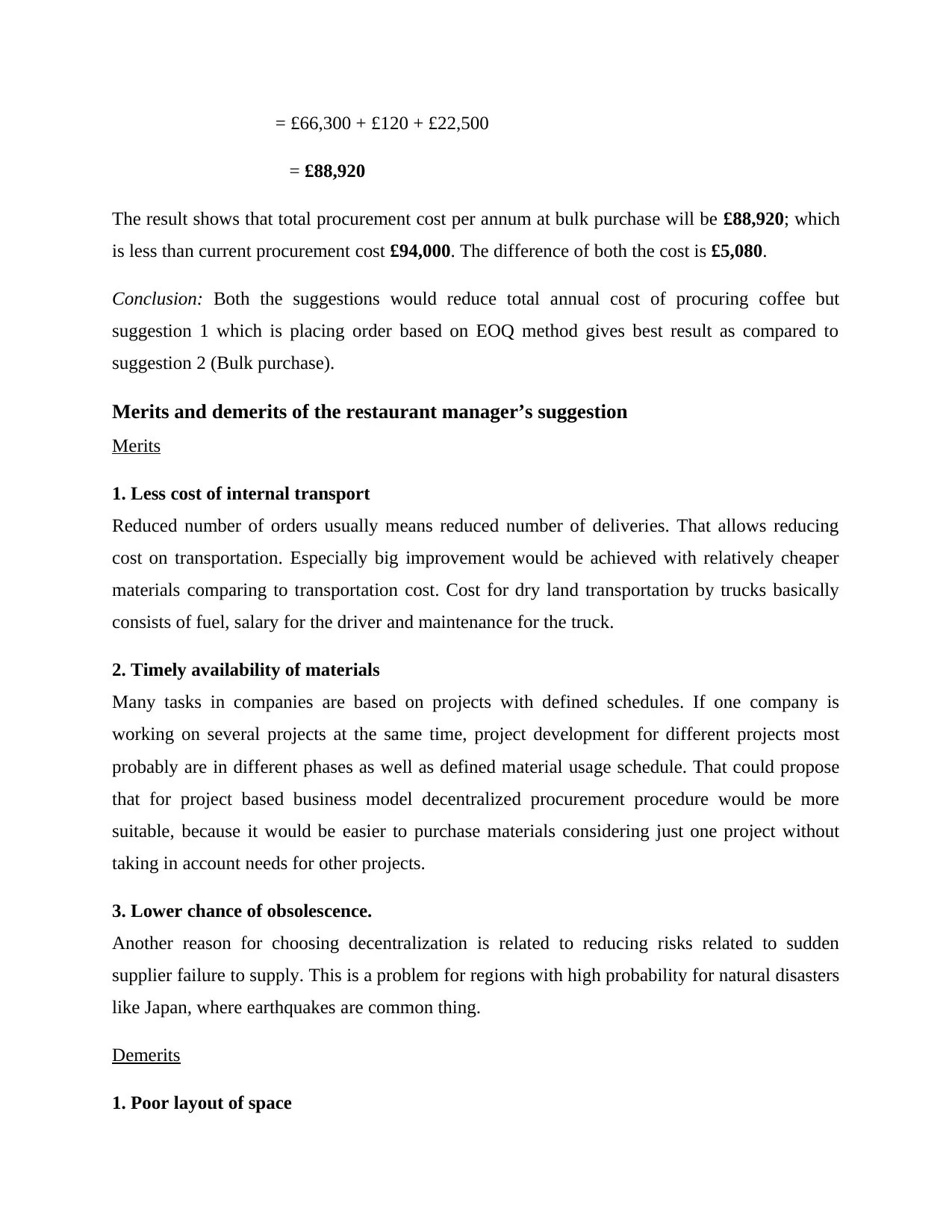
= £66,300 + £120 + £22,500
= £88,920
The result shows that total procurement cost per annum at bulk purchase will be £88,920; which
is less than current procurement cost £94,000. The difference of both the cost is £5,080.
Conclusion: Both the suggestions would reduce total annual cost of procuring coffee but
suggestion 1 which is placing order based on EOQ method gives best result as compared to
suggestion 2 (Bulk purchase).
Merits and demerits of the restaurant manager’s suggestion
Merits
1. Less cost of internal transport
Reduced number of orders usually means reduced number of deliveries. That allows reducing
cost on transportation. Especially big improvement would be achieved with relatively cheaper
materials comparing to transportation cost. Cost for dry land transportation by trucks basically
consists of fuel, salary for the driver and maintenance for the truck.
2. Timely availability of materials
Many tasks in companies are based on projects with defined schedules. If one company is
working on several projects at the same time, project development for different projects most
probably are in different phases as well as defined material usage schedule. That could propose
that for project based business model decentralized procurement procedure would be more
suitable, because it would be easier to purchase materials considering just one project without
taking in account needs for other projects.
3. Lower chance of obsolescence.
Another reason for choosing decentralization is related to reducing risks related to sudden
supplier failure to supply. This is a problem for regions with high probability for natural disasters
like Japan, where earthquakes are common thing.
Demerits
1. Poor layout of space
= £88,920
The result shows that total procurement cost per annum at bulk purchase will be £88,920; which
is less than current procurement cost £94,000. The difference of both the cost is £5,080.
Conclusion: Both the suggestions would reduce total annual cost of procuring coffee but
suggestion 1 which is placing order based on EOQ method gives best result as compared to
suggestion 2 (Bulk purchase).
Merits and demerits of the restaurant manager’s suggestion
Merits
1. Less cost of internal transport
Reduced number of orders usually means reduced number of deliveries. That allows reducing
cost on transportation. Especially big improvement would be achieved with relatively cheaper
materials comparing to transportation cost. Cost for dry land transportation by trucks basically
consists of fuel, salary for the driver and maintenance for the truck.
2. Timely availability of materials
Many tasks in companies are based on projects with defined schedules. If one company is
working on several projects at the same time, project development for different projects most
probably are in different phases as well as defined material usage schedule. That could propose
that for project based business model decentralized procurement procedure would be more
suitable, because it would be easier to purchase materials considering just one project without
taking in account needs for other projects.
3. Lower chance of obsolescence.
Another reason for choosing decentralization is related to reducing risks related to sudden
supplier failure to supply. This is a problem for regions with high probability for natural disasters
like Japan, where earthquakes are common thing.
Demerits
1. Poor layout of space
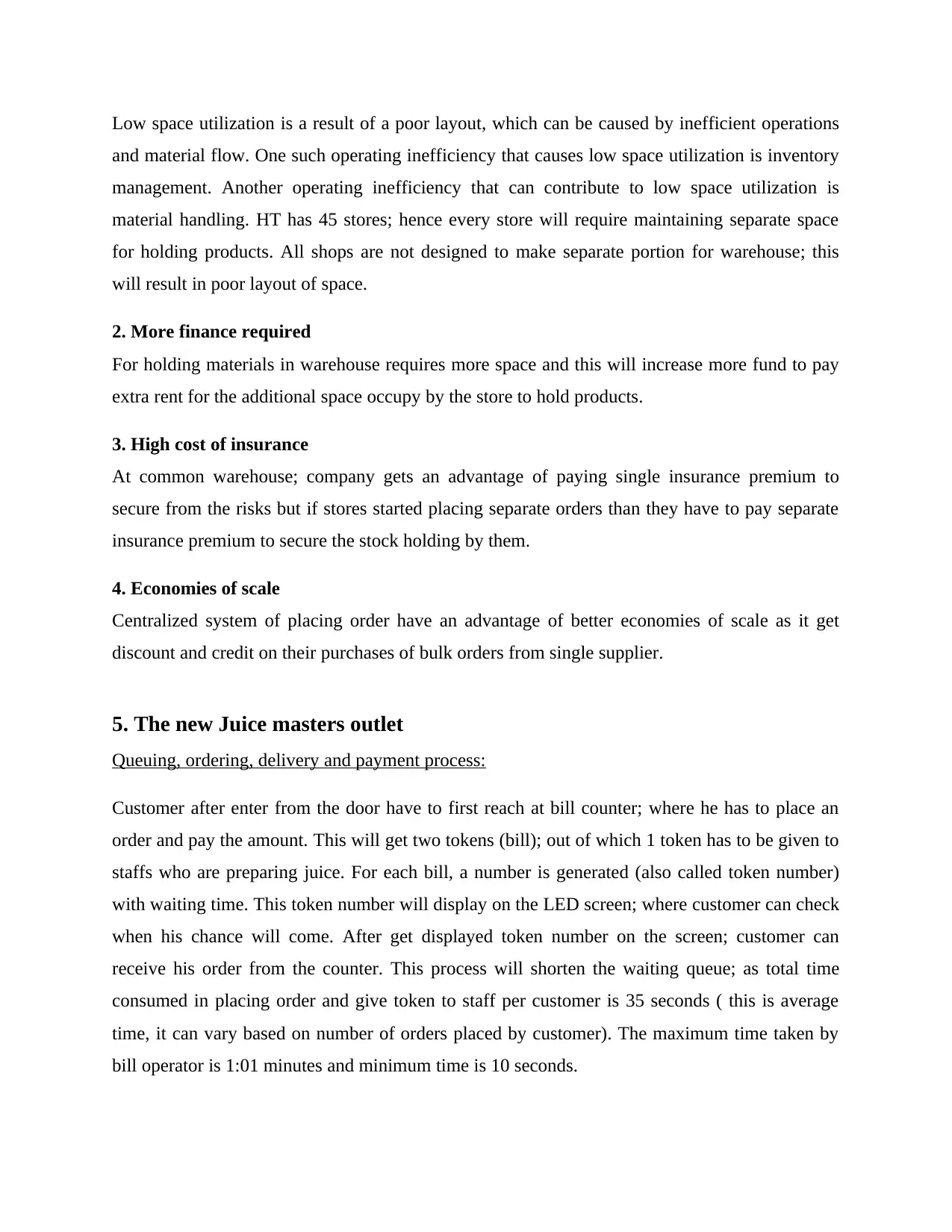
Low space utilization is a result of a poor layout, which can be caused by inefficient operations
and material flow. One such operating inefficiency that causes low space utilization is inventory
management. Another operating inefficiency that can contribute to low space utilization is
material handling. HT has 45 stores; hence every store will require maintaining separate space
for holding products. All shops are not designed to make separate portion for warehouse; this
will result in poor layout of space.
2. More finance required
For holding materials in warehouse requires more space and this will increase more fund to pay
extra rent for the additional space occupy by the store to hold products.
3. High cost of insurance
At common warehouse; company gets an advantage of paying single insurance premium to
secure from the risks but if stores started placing separate orders than they have to pay separate
insurance premium to secure the stock holding by them.
4. Economies of scale
Centralized system of placing order have an advantage of better economies of scale as it get
discount and credit on their purchases of bulk orders from single supplier.
5. The new Juice masters outlet
Queuing, ordering, delivery and payment process:
Customer after enter from the door have to first reach at bill counter; where he has to place an
order and pay the amount. This will get two tokens (bill); out of which 1 token has to be given to
staffs who are preparing juice. For each bill, a number is generated (also called token number)
with waiting time. This token number will display on the LED screen; where customer can check
when his chance will come. After get displayed token number on the screen; customer can
receive his order from the counter. This process will shorten the waiting queue; as total time
consumed in placing order and give token to staff per customer is 35 seconds ( this is average
time, it can vary based on number of orders placed by customer). The maximum time taken by
bill operator is 1:01 minutes and minimum time is 10 seconds.
and material flow. One such operating inefficiency that causes low space utilization is inventory
management. Another operating inefficiency that can contribute to low space utilization is
material handling. HT has 45 stores; hence every store will require maintaining separate space
for holding products. All shops are not designed to make separate portion for warehouse; this
will result in poor layout of space.
2. More finance required
For holding materials in warehouse requires more space and this will increase more fund to pay
extra rent for the additional space occupy by the store to hold products.
3. High cost of insurance
At common warehouse; company gets an advantage of paying single insurance premium to
secure from the risks but if stores started placing separate orders than they have to pay separate
insurance premium to secure the stock holding by them.
4. Economies of scale
Centralized system of placing order have an advantage of better economies of scale as it get
discount and credit on their purchases of bulk orders from single supplier.
5. The new Juice masters outlet
Queuing, ordering, delivery and payment process:
Customer after enter from the door have to first reach at bill counter; where he has to place an
order and pay the amount. This will get two tokens (bill); out of which 1 token has to be given to
staffs who are preparing juice. For each bill, a number is generated (also called token number)
with waiting time. This token number will display on the LED screen; where customer can check
when his chance will come. After get displayed token number on the screen; customer can
receive his order from the counter. This process will shorten the waiting queue; as total time
consumed in placing order and give token to staff per customer is 35 seconds ( this is average
time, it can vary based on number of orders placed by customer). The maximum time taken by
bill operator is 1:01 minutes and minimum time is 10 seconds.
⊘ This is a preview!⊘
Do you want full access?
Subscribe today to unlock all pages.

Trusted by 1+ million students worldwide
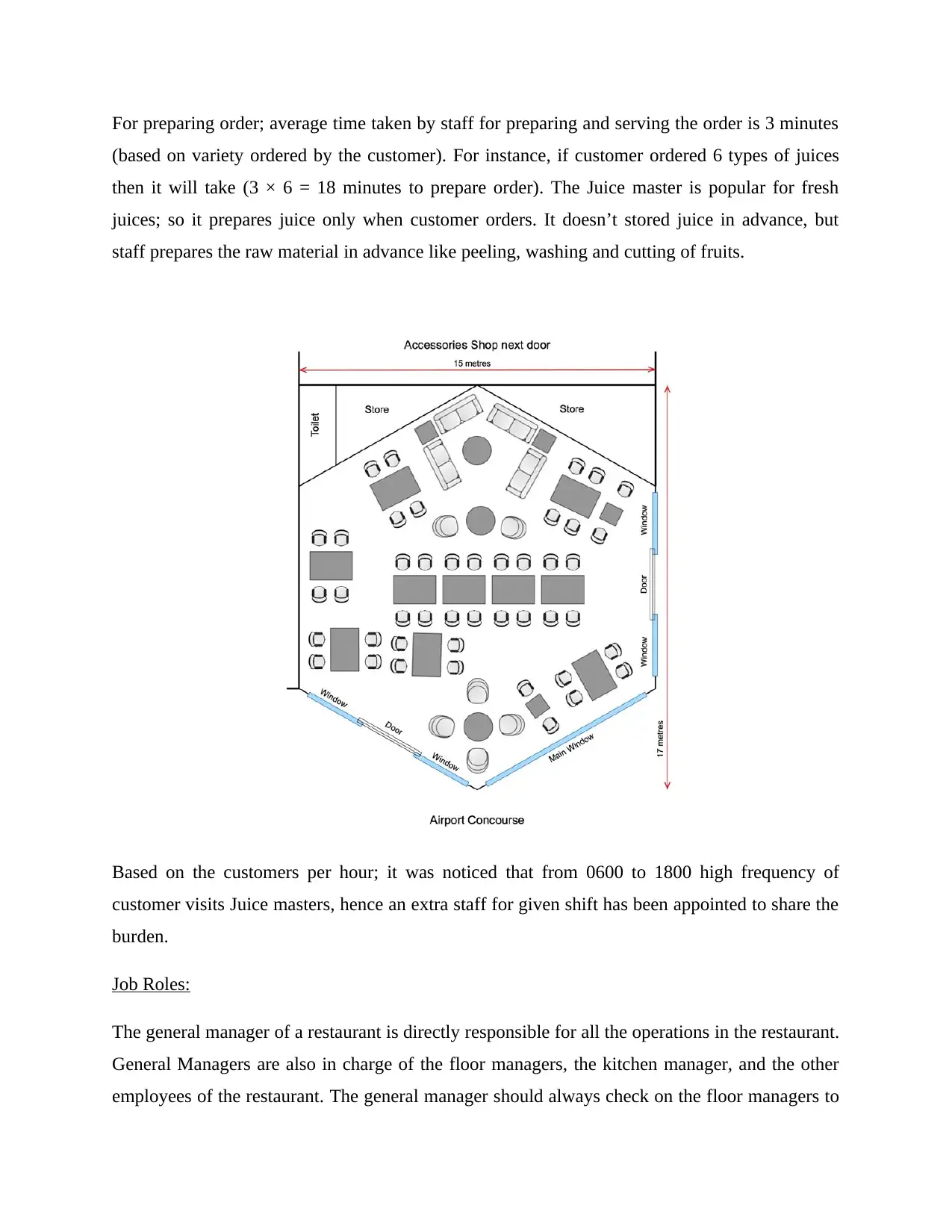
For preparing order; average time taken by staff for preparing and serving the order is 3 minutes
(based on variety ordered by the customer). For instance, if customer ordered 6 types of juices
then it will take (3 × 6 = 18 minutes to prepare order). The Juice master is popular for fresh
juices; so it prepares juice only when customer orders. It doesn’t stored juice in advance, but
staff prepares the raw material in advance like peeling, washing and cutting of fruits.
Based on the customers per hour; it was noticed that from 0600 to 1800 high frequency of
customer visits Juice masters, hence an extra staff for given shift has been appointed to share the
burden.
Job Roles:
The general manager of a restaurant is directly responsible for all the operations in the restaurant.
General Managers are also in charge of the floor managers, the kitchen manager, and the other
employees of the restaurant. The general manager should always check on the floor managers to
(based on variety ordered by the customer). For instance, if customer ordered 6 types of juices
then it will take (3 × 6 = 18 minutes to prepare order). The Juice master is popular for fresh
juices; so it prepares juice only when customer orders. It doesn’t stored juice in advance, but
staff prepares the raw material in advance like peeling, washing and cutting of fruits.
Based on the customers per hour; it was noticed that from 0600 to 1800 high frequency of
customer visits Juice masters, hence an extra staff for given shift has been appointed to share the
burden.
Job Roles:
The general manager of a restaurant is directly responsible for all the operations in the restaurant.
General Managers are also in charge of the floor managers, the kitchen manager, and the other
employees of the restaurant. The general manager should always check on the floor managers to
Paraphrase This Document
Need a fresh take? Get an instant paraphrase of this document with our AI Paraphraser
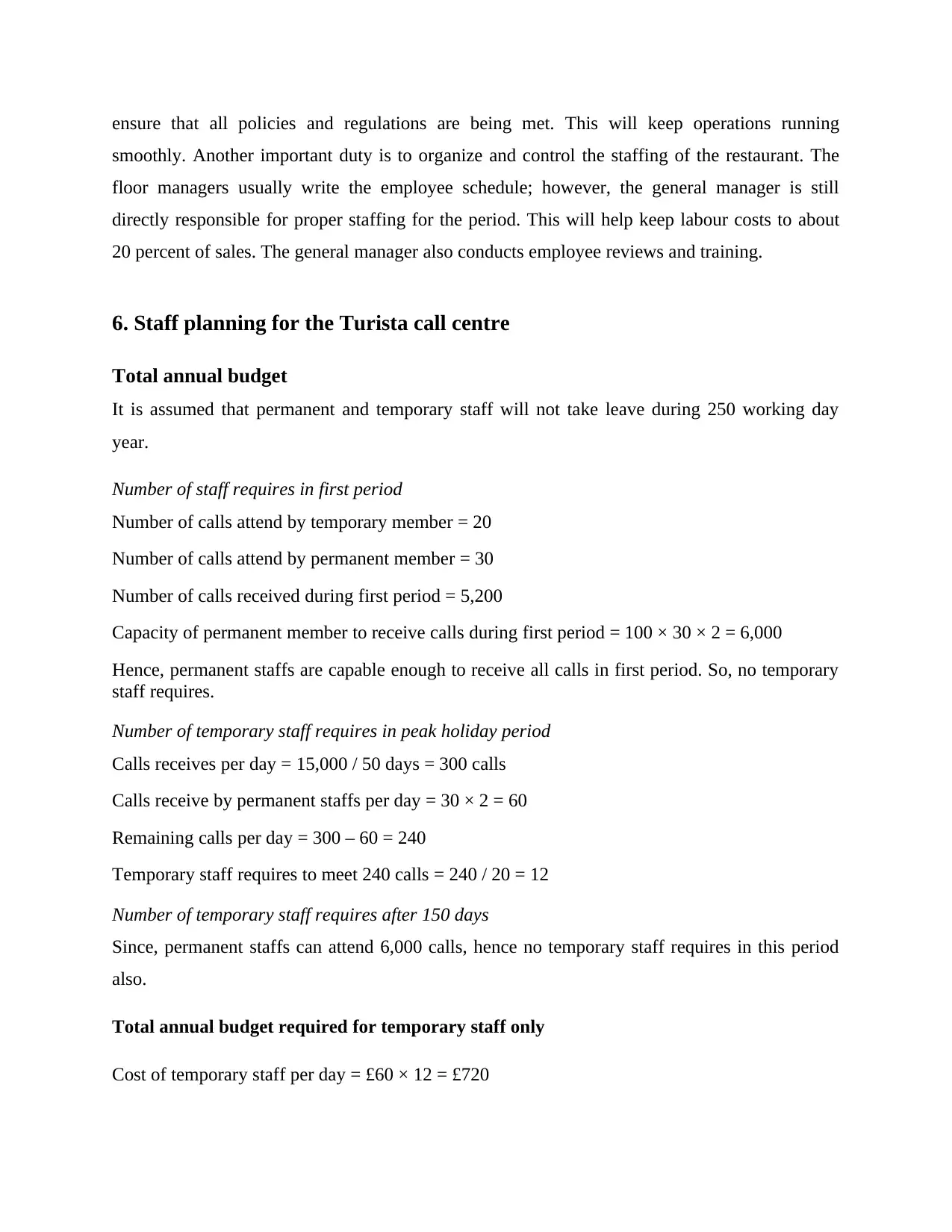
ensure that all policies and regulations are being met. This will keep operations running
smoothly. Another important duty is to organize and control the staffing of the restaurant. The
floor managers usually write the employee schedule; however, the general manager is still
directly responsible for proper staffing for the period. This will help keep labour costs to about
20 percent of sales. The general manager also conducts employee reviews and training.
6. Staff planning for the Turista call centre
Total annual budget
It is assumed that permanent and temporary staff will not take leave during 250 working day
year.
Number of staff requires in first period
Number of calls attend by temporary member = 20
Number of calls attend by permanent member = 30
Number of calls received during first period = 5,200
Capacity of permanent member to receive calls during first period = 100 × 30 × 2 = 6,000
Hence, permanent staffs are capable enough to receive all calls in first period. So, no temporary
staff requires.
Number of temporary staff requires in peak holiday period
Calls receives per day = 15,000 / 50 days = 300 calls
Calls receive by permanent staffs per day = 30 × 2 = 60
Remaining calls per day = 300 – 60 = 240
Temporary staff requires to meet 240 calls = 240 / 20 = 12
Number of temporary staff requires after 150 days
Since, permanent staffs can attend 6,000 calls, hence no temporary staff requires in this period
also.
Total annual budget required for temporary staff only
Cost of temporary staff per day = £60 × 12 = £720
smoothly. Another important duty is to organize and control the staffing of the restaurant. The
floor managers usually write the employee schedule; however, the general manager is still
directly responsible for proper staffing for the period. This will help keep labour costs to about
20 percent of sales. The general manager also conducts employee reviews and training.
6. Staff planning for the Turista call centre
Total annual budget
It is assumed that permanent and temporary staff will not take leave during 250 working day
year.
Number of staff requires in first period
Number of calls attend by temporary member = 20
Number of calls attend by permanent member = 30
Number of calls received during first period = 5,200
Capacity of permanent member to receive calls during first period = 100 × 30 × 2 = 6,000
Hence, permanent staffs are capable enough to receive all calls in first period. So, no temporary
staff requires.
Number of temporary staff requires in peak holiday period
Calls receives per day = 15,000 / 50 days = 300 calls
Calls receive by permanent staffs per day = 30 × 2 = 60
Remaining calls per day = 300 – 60 = 240
Temporary staff requires to meet 240 calls = 240 / 20 = 12
Number of temporary staff requires after 150 days
Since, permanent staffs can attend 6,000 calls, hence no temporary staff requires in this period
also.
Total annual budget required for temporary staff only
Cost of temporary staff per day = £60 × 12 = £720
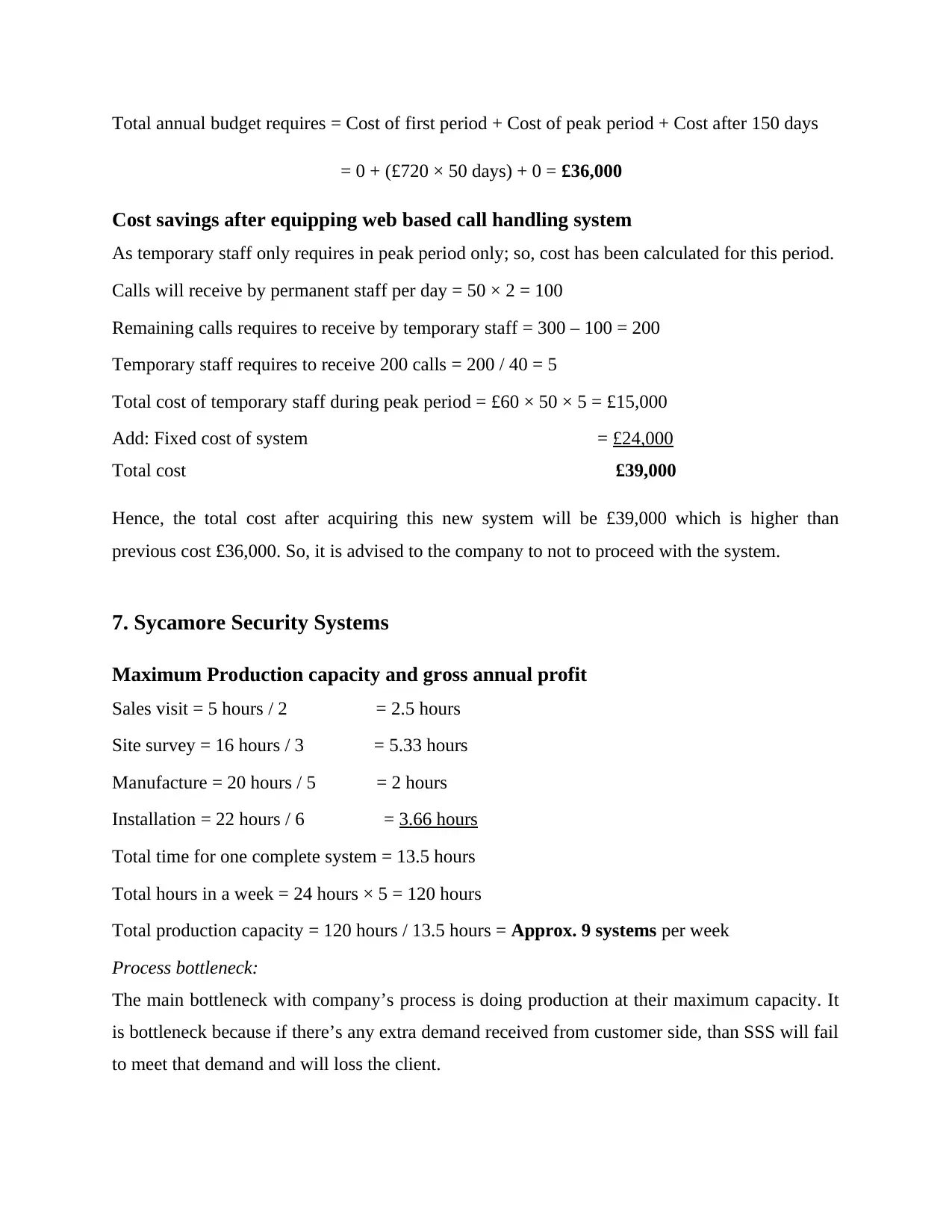
Total annual budget requires = Cost of first period + Cost of peak period + Cost after 150 days
= 0 + (£720 × 50 days) + 0 = £36,000
Cost savings after equipping web based call handling system
As temporary staff only requires in peak period only; so, cost has been calculated for this period.
Calls will receive by permanent staff per day = 50 × 2 = 100
Remaining calls requires to receive by temporary staff = 300 – 100 = 200
Temporary staff requires to receive 200 calls = 200 / 40 = 5
Total cost of temporary staff during peak period = £60 × 50 × 5 = £15,000
Add: Fixed cost of system = £24,000
Total cost £39,000
Hence, the total cost after acquiring this new system will be £39,000 which is higher than
previous cost £36,000. So, it is advised to the company to not to proceed with the system.
7. Sycamore Security Systems
Maximum Production capacity and gross annual profit
Sales visit = 5 hours / 2 = 2.5 hours
Site survey = 16 hours / 3 = 5.33 hours
Manufacture = 20 hours / 5 = 2 hours
Installation = 22 hours / 6 = 3.66 hours
Total time for one complete system = 13.5 hours
Total hours in a week = 24 hours × 5 = 120 hours
Total production capacity = 120 hours / 13.5 hours = Approx. 9 systems per week
Process bottleneck:
The main bottleneck with company’s process is doing production at their maximum capacity. It
is bottleneck because if there’s any extra demand received from customer side, than SSS will fail
to meet that demand and will loss the client.
= 0 + (£720 × 50 days) + 0 = £36,000
Cost savings after equipping web based call handling system
As temporary staff only requires in peak period only; so, cost has been calculated for this period.
Calls will receive by permanent staff per day = 50 × 2 = 100
Remaining calls requires to receive by temporary staff = 300 – 100 = 200
Temporary staff requires to receive 200 calls = 200 / 40 = 5
Total cost of temporary staff during peak period = £60 × 50 × 5 = £15,000
Add: Fixed cost of system = £24,000
Total cost £39,000
Hence, the total cost after acquiring this new system will be £39,000 which is higher than
previous cost £36,000. So, it is advised to the company to not to proceed with the system.
7. Sycamore Security Systems
Maximum Production capacity and gross annual profit
Sales visit = 5 hours / 2 = 2.5 hours
Site survey = 16 hours / 3 = 5.33 hours
Manufacture = 20 hours / 5 = 2 hours
Installation = 22 hours / 6 = 3.66 hours
Total time for one complete system = 13.5 hours
Total hours in a week = 24 hours × 5 = 120 hours
Total production capacity = 120 hours / 13.5 hours = Approx. 9 systems per week
Process bottleneck:
The main bottleneck with company’s process is doing production at their maximum capacity. It
is bottleneck because if there’s any extra demand received from customer side, than SSS will fail
to meet that demand and will loss the client.
⊘ This is a preview!⊘
Do you want full access?
Subscribe today to unlock all pages.

Trusted by 1+ million students worldwide
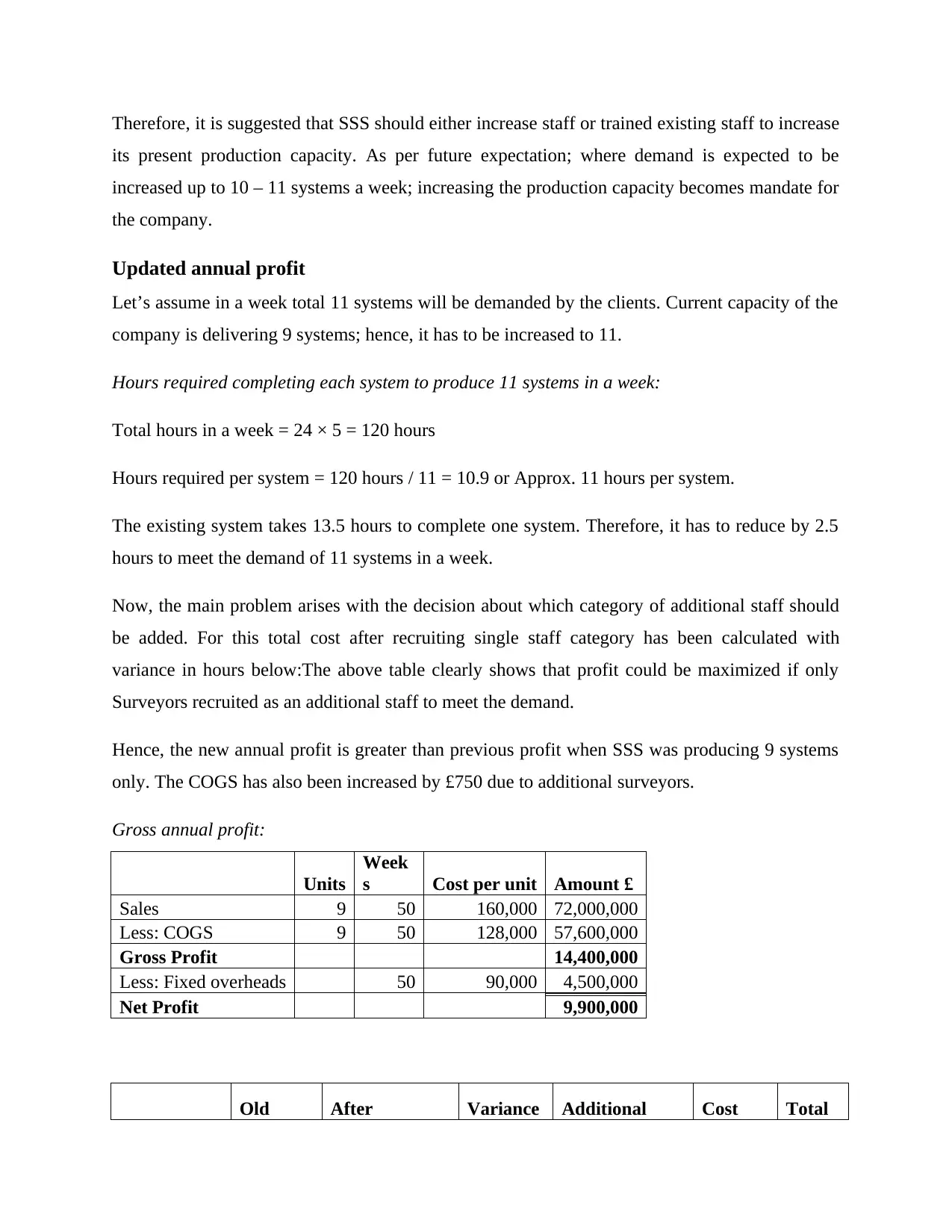
Therefore, it is suggested that SSS should either increase staff or trained existing staff to increase
its present production capacity. As per future expectation; where demand is expected to be
increased up to 10 – 11 systems a week; increasing the production capacity becomes mandate for
the company.
Updated annual profit
Let’s assume in a week total 11 systems will be demanded by the clients. Current capacity of the
company is delivering 9 systems; hence, it has to be increased to 11.
Hours required completing each system to produce 11 systems in a week:
Total hours in a week = 24 × 5 = 120 hours
Hours required per system = 120 hours / 11 = 10.9 or Approx. 11 hours per system.
The existing system takes 13.5 hours to complete one system. Therefore, it has to reduce by 2.5
hours to meet the demand of 11 systems in a week.
Now, the main problem arises with the decision about which category of additional staff should
be added. For this total cost after recruiting single staff category has been calculated with
variance in hours below:The above table clearly shows that profit could be maximized if only
Surveyors recruited as an additional staff to meet the demand.
Hence, the new annual profit is greater than previous profit when SSS was producing 9 systems
only. The COGS has also been increased by £750 due to additional surveyors.
Gross annual profit:
Units
Week
s Cost per unit Amount £
Sales 9 50 160,000 72,000,000
Less: COGS 9 50 128,000 57,600,000
Gross Profit 14,400,000
Less: Fixed overheads 50 90,000 4,500,000
Net Profit 9,900,000
Old After Variance Additional Cost Total
its present production capacity. As per future expectation; where demand is expected to be
increased up to 10 – 11 systems a week; increasing the production capacity becomes mandate for
the company.
Updated annual profit
Let’s assume in a week total 11 systems will be demanded by the clients. Current capacity of the
company is delivering 9 systems; hence, it has to be increased to 11.
Hours required completing each system to produce 11 systems in a week:
Total hours in a week = 24 × 5 = 120 hours
Hours required per system = 120 hours / 11 = 10.9 or Approx. 11 hours per system.
The existing system takes 13.5 hours to complete one system. Therefore, it has to reduce by 2.5
hours to meet the demand of 11 systems in a week.
Now, the main problem arises with the decision about which category of additional staff should
be added. For this total cost after recruiting single staff category has been calculated with
variance in hours below:The above table clearly shows that profit could be maximized if only
Surveyors recruited as an additional staff to meet the demand.
Hence, the new annual profit is greater than previous profit when SSS was producing 9 systems
only. The COGS has also been increased by £750 due to additional surveyors.
Gross annual profit:
Units
Week
s Cost per unit Amount £
Sales 9 50 160,000 72,000,000
Less: COGS 9 50 128,000 57,600,000
Gross Profit 14,400,000
Less: Fixed overheads 50 90,000 4,500,000
Net Profit 9,900,000
Old After Variance Additional Cost Total
Paraphrase This Document
Need a fresh take? Get an instant paraphrase of this document with our AI Paraphraser
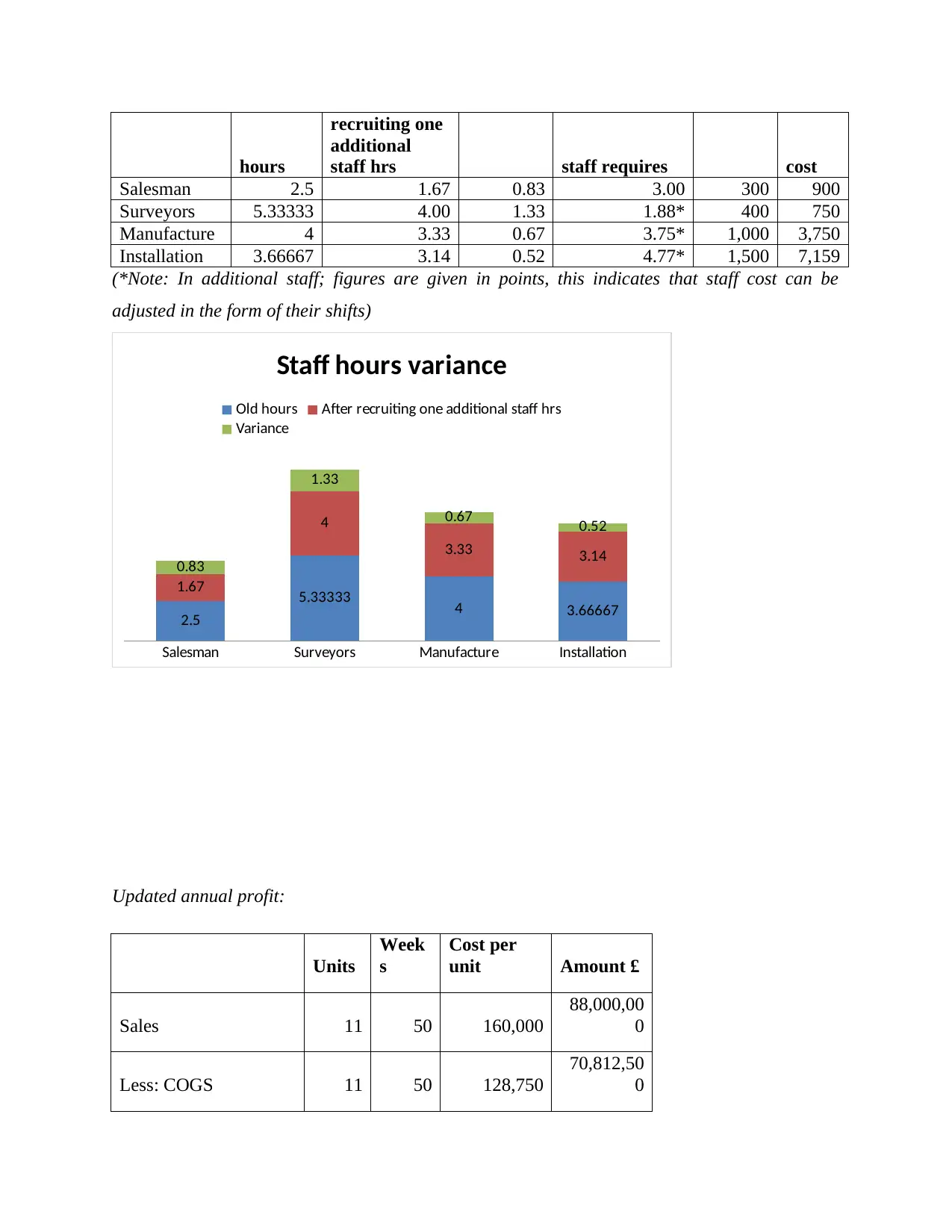
hours
recruiting one
additional
staff hrs staff requires cost
Salesman 2.5 1.67 0.83 3.00 300 900
Surveyors 5.33333 4.00 1.33 1.88* 400 750
Manufacture 4 3.33 0.67 3.75* 1,000 3,750
Installation 3.66667 3.14 0.52 4.77* 1,500 7,159
(*Note: In additional staff; figures are given in points, this indicates that staff cost can be
adjusted in the form of their shifts)
Salesman Surveyors Manufacture Installation
2.5
5.33333 4 3.66667
1.67
4
3.33 3.14
0.83
1.33
0.67 0.52
Staff hours variance
Old hours After recruiting one additional staff hrs
Variance
Updated annual profit:
Units
Week
s
Cost per
unit Amount £
Sales 11 50 160,000
88,000,00
0
Less: COGS 11 50 128,750
70,812,50
0
recruiting one
additional
staff hrs staff requires cost
Salesman 2.5 1.67 0.83 3.00 300 900
Surveyors 5.33333 4.00 1.33 1.88* 400 750
Manufacture 4 3.33 0.67 3.75* 1,000 3,750
Installation 3.66667 3.14 0.52 4.77* 1,500 7,159
(*Note: In additional staff; figures are given in points, this indicates that staff cost can be
adjusted in the form of their shifts)
Salesman Surveyors Manufacture Installation
2.5
5.33333 4 3.66667
1.67
4
3.33 3.14
0.83
1.33
0.67 0.52
Staff hours variance
Old hours After recruiting one additional staff hrs
Variance
Updated annual profit:
Units
Week
s
Cost per
unit Amount £
Sales 11 50 160,000
88,000,00
0
Less: COGS 11 50 128,750
70,812,50
0
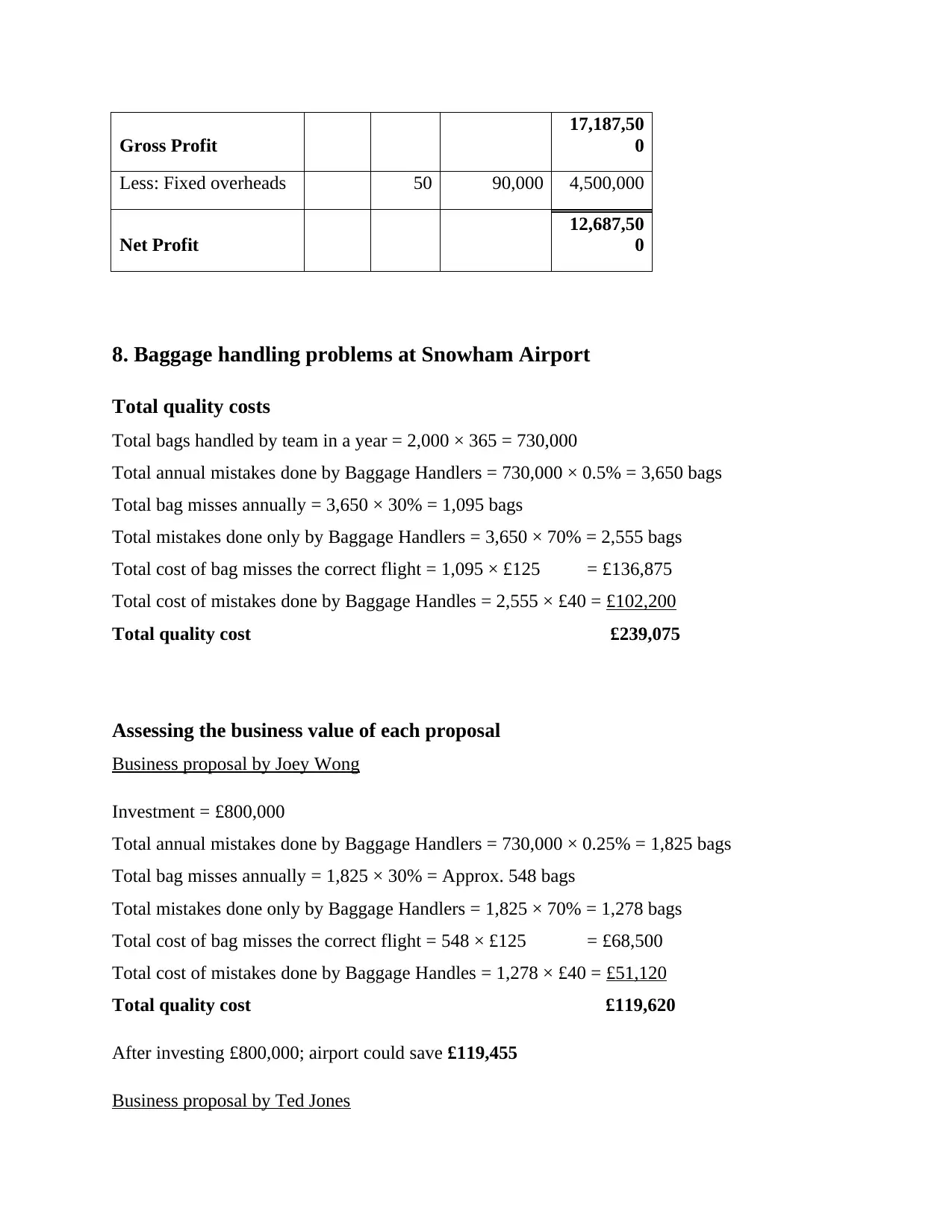
Gross Profit
17,187,50
0
Less: Fixed overheads 50 90,000 4,500,000
Net Profit
12,687,50
0
8. Baggage handling problems at Snowham Airport
Total quality costs
Total bags handled by team in a year = 2,000 × 365 = 730,000
Total annual mistakes done by Baggage Handlers = 730,000 × 0.5% = 3,650 bags
Total bag misses annually = 3,650 × 30% = 1,095 bags
Total mistakes done only by Baggage Handlers = 3,650 × 70% = 2,555 bags
Total cost of bag misses the correct flight = 1,095 × £125 = £136,875
Total cost of mistakes done by Baggage Handles = 2,555 × £40 = £102,200
Total quality cost £239,075
Assessing the business value of each proposal
Business proposal by Joey Wong
Investment = £800,000
Total annual mistakes done by Baggage Handlers = 730,000 × 0.25% = 1,825 bags
Total bag misses annually = 1,825 × 30% = Approx. 548 bags
Total mistakes done only by Baggage Handlers = 1,825 × 70% = 1,278 bags
Total cost of bag misses the correct flight = 548 × £125 = £68,500
Total cost of mistakes done by Baggage Handles = 1,278 × £40 = £51,120
Total quality cost £119,620
After investing £800,000; airport could save £119,455
Business proposal by Ted Jones
17,187,50
0
Less: Fixed overheads 50 90,000 4,500,000
Net Profit
12,687,50
0
8. Baggage handling problems at Snowham Airport
Total quality costs
Total bags handled by team in a year = 2,000 × 365 = 730,000
Total annual mistakes done by Baggage Handlers = 730,000 × 0.5% = 3,650 bags
Total bag misses annually = 3,650 × 30% = 1,095 bags
Total mistakes done only by Baggage Handlers = 3,650 × 70% = 2,555 bags
Total cost of bag misses the correct flight = 1,095 × £125 = £136,875
Total cost of mistakes done by Baggage Handles = 2,555 × £40 = £102,200
Total quality cost £239,075
Assessing the business value of each proposal
Business proposal by Joey Wong
Investment = £800,000
Total annual mistakes done by Baggage Handlers = 730,000 × 0.25% = 1,825 bags
Total bag misses annually = 1,825 × 30% = Approx. 548 bags
Total mistakes done only by Baggage Handlers = 1,825 × 70% = 1,278 bags
Total cost of bag misses the correct flight = 548 × £125 = £68,500
Total cost of mistakes done by Baggage Handles = 1,278 × £40 = £51,120
Total quality cost £119,620
After investing £800,000; airport could save £119,455
Business proposal by Ted Jones
⊘ This is a preview!⊘
Do you want full access?
Subscribe today to unlock all pages.

Trusted by 1+ million students worldwide
1 out of 19
Related Documents
Your All-in-One AI-Powered Toolkit for Academic Success.
+13062052269
info@desklib.com
Available 24*7 on WhatsApp / Email
![[object Object]](/_next/static/media/star-bottom.7253800d.svg)
Unlock your academic potential
Copyright © 2020–2025 A2Z Services. All Rights Reserved. Developed and managed by ZUCOL.





